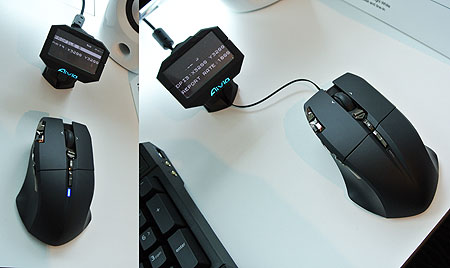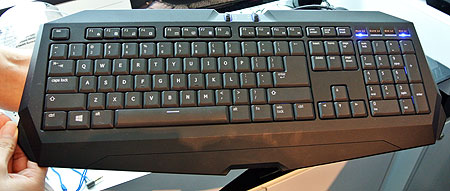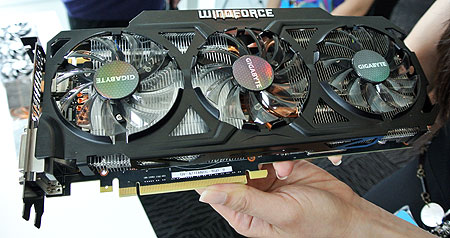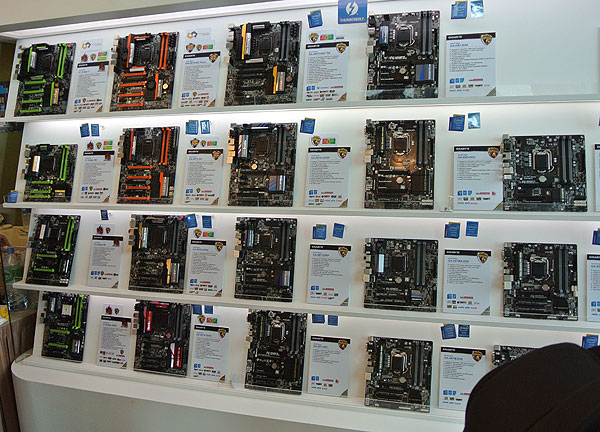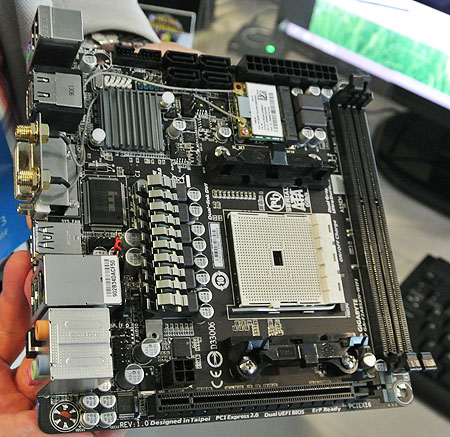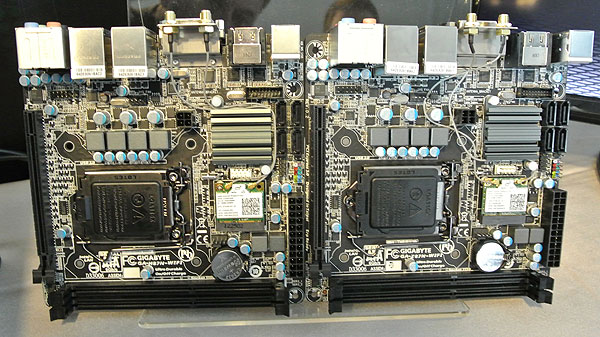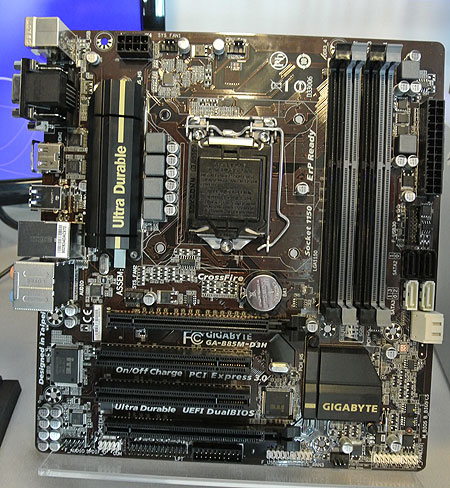Computex 2013: Motherboards, Peripherals, And Mobility
Gigabyte At Computex
Upon arriving to Gigabyte's booth, the company started by showing a selection of peripherals. It has a new mouse under its Aivia brand called the Neon. Naturally, you can use it like any other mouse. Or, there's a gyroscope inside that lets you wave it around in the air to control the cursor that way. It also has a built-in laser pointer and comes bundled with software enabling on-screen drawing. The USB wireless dongle doubles as a charging cable, and Gigabyte says 10 minutes plugged in is enough to keep the Neon going for three hours.
Aivia's Uranium is a more gaming-oriented design with an OLED-equipped wireless receiver. This wireless mouse can operate in wired mode if charging is necessary. The display can help assign macros or display the mouse's status. The receiver is also useful for storing configuration information. Expect the Uranium to surface soon for roughly $130.
The last peripheral we were shown was Aivia's Force K7 keyboard, featuring ultra-short key travel for gamers interested in quick response. It features selectable blue, green, and cyan lighting behind the keys, though the letters themselves aren't illuminated.
Gigabyte then showed off its latest Windforce cooling system, armed with a metal shroud. The company says it's able to contend with a 450 W thermal load, and proved the design's mettle by demonstrating it attached to a constant heat source. We've already seen the newest Windforce design on Gigabyte's GeForce GTX 770, though it's also in use on an overclocked GeForce GTX 780 and will soon show up on a GK110-equipped Titan card. You'll have the option to swap out Nvidia's stock cooler with Gigabyte's Windforce solution.
Inevitably, we made our way to Gigabyte's unavoidable motherboard display. The company launched more than 40 models. It's tweaking with its color scheme, and we saw a lot of black PCBs with beefy heat sinks and more power phases (perhaps ironic given the voltage regulator integration inherent to Haswell). There are more red- and gold-colored products. Gigabyte's representative let us know that the-UD4 line-up is being positioned against Asus' RoG products at lower prices, but similar features.
The mini-ITX F2A85XN-WIFI caught our eye, based on AMD's Socket FM2 platform with Richland APU support. This board comes equipped with a Bluetooth 4.0/Wi-Fi module and enables AMD’s Wireless Display technology. We’re told the original prototype didn’t overclock well, so Gigabyte went back to the drawing board and got higher-end power components to combat this.
The Z87X-UD5 is an upper-mainstream platform with dual Thunderbolt ports, on-board 802.11ac, and Bluetooth 4.0. Gigabyte's demo was driving a 4K screen from a single Thunderbolt cable. Note the red accents; Gigabyte claims its customers were requesting this specifically.
Get Tom's Hardware's best news and in-depth reviews, straight to your inbox.
Next up, the H87N-WIFI and Z87N-WIFI. These products include a wireless module that extends support for Intel's WiDi technology.
The Intel Small Business Advantage platform, which bundles software tools for blocking USB ports, managing security, and automating backup, is like a cheaper version of vPro without the enterprise-class remote control and assistance features. It bridges a gap in the SMB market that Gigbayte says sells really well. Intel includes this functionality with boards based on the H87 and B85 Express chipset, and vendors can enable it on their products as Gigabyte does with the B85M-D3H and H87N-WIFI.
Current page: Gigabyte At Computex
Prev Page Trendnet And Roccat At Computex Next Page Gigabyte, ContinuedDon Woligroski was a former senior hardware editor for Tom's Hardware. He has covered a wide range of PC hardware topics, including CPUs, GPUs, system building, and emerging technologies.
-
ojas "Surprise, it runs Android"Reply
What's the surprise? All intel-based phones run Android...in fact, Intel explicitly expressed a lack of desire to enter the WP market for the time being.
And the K900's launched in India too, now. -
RedJaron I'd be interested to know how MSI runs their OC line cooling test. A 4.6GHz CPU will need some kind of active cooling, and that cooler will at least partially induct some airflow over the VRM. Or do they just simulate the CPU with a current draw? And speaking of VRM, I thought Haswell brought the VRM into the CPU, so what do these massive 20 phase VRMs do?Reply -
laststop311 28 watt iris 5100 ultrabook chips increases the bloodflow to certain parts of my body. You can pretty much do very very good 768p casual gaming on the iris 5100. This will make some for really really thin and sexy laptops.Reply
How is this for a mind blower The Asus Zenbook infinity is so super sexy looking. Now the iris pro is only on standard voltage so I know we won't see that but the ultrabook level cpu's do have HD IRIS 5100 support Now since 2560x1440 is double 1280x720 should be able to game at 1280x720 with perfect scaling just much better clarity. And The Iris Pro 5100 (especially if you keep cpu stock and use all your tdp headroom to OC the graphics) it will be able to run pretty much any game with many on high setting and med high) at a relatively easy 1280x720 resolution.
That new infinity may even be a decently fun casual gamer machine too. I'm freaking in love. I need to marry it already. -
8350rocks Meh, some of the gigabyte stuff was cool...not much love for AMD oriented products this time though. I like the direction MSI is going, if they can get that product out...I would consider it for my next build.Reply

